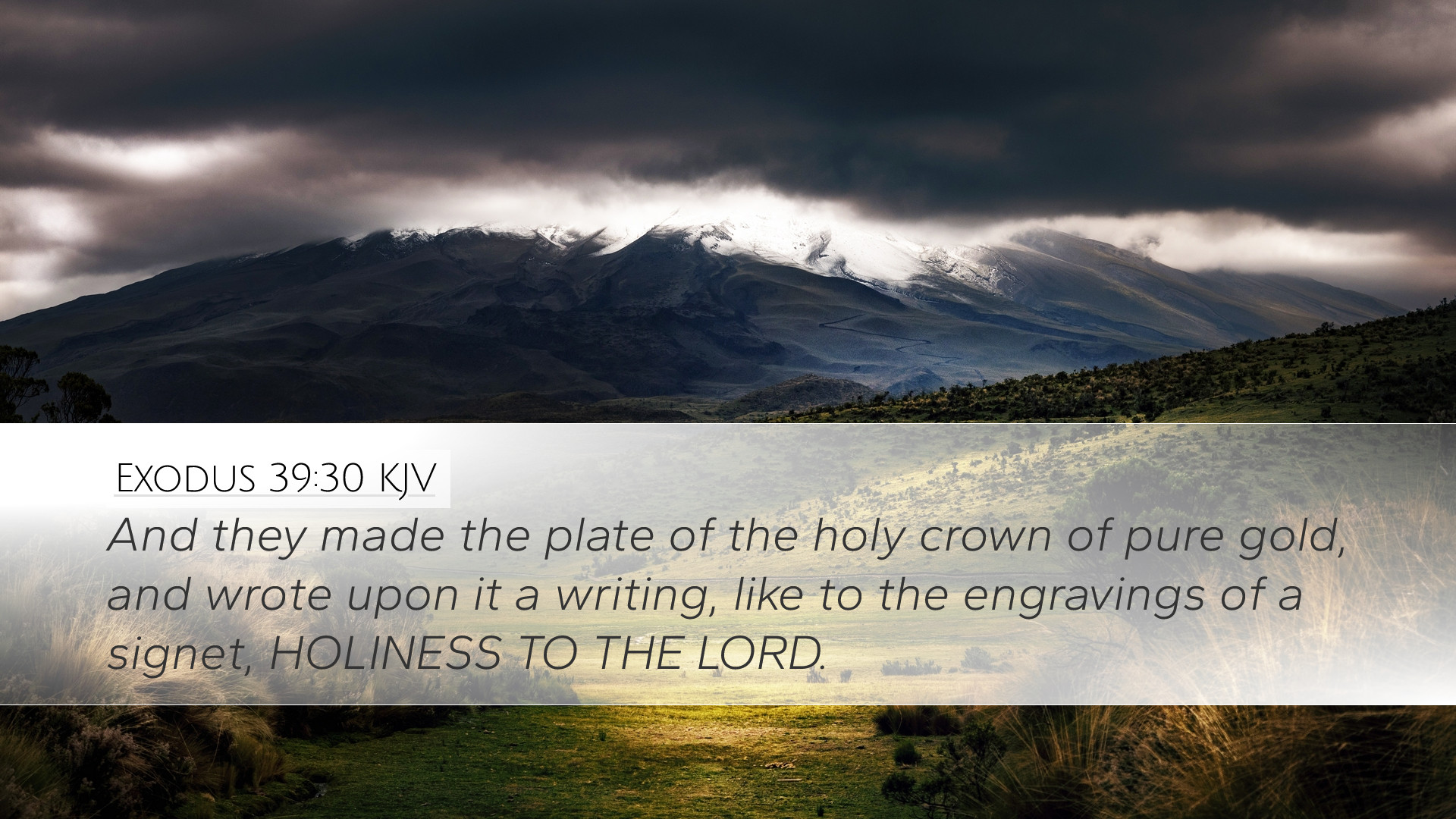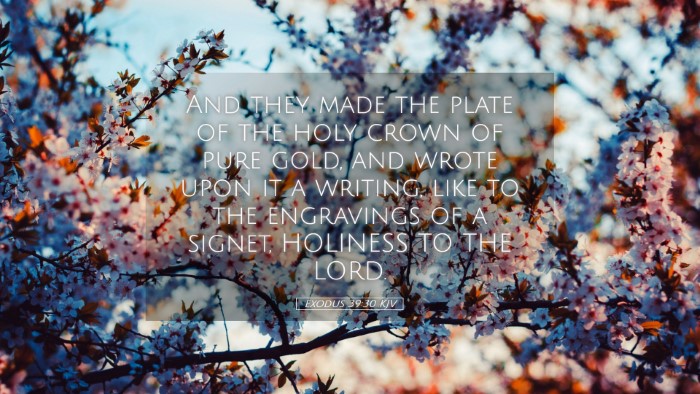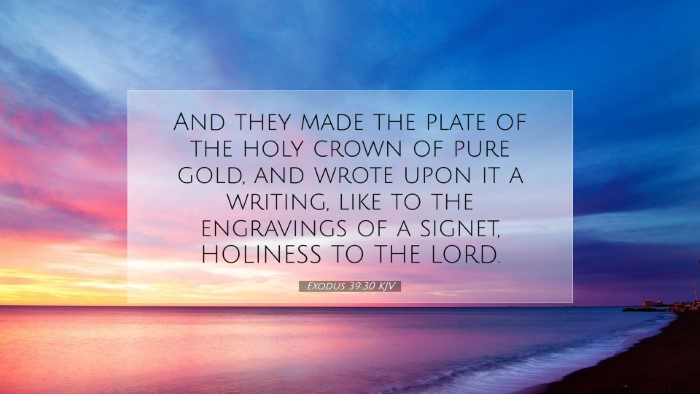Exodus 39:30 Commentary
Verse: "And they made the plate of the holy crown of pure gold, and wrote upon it a writing, like to the engravings of a signet, HOLINESS TO THE LORD."
Introduction
The passage of Exodus 39:30 describes a significant element of the high priest’s attire—the golden plate, inscribed with "HOLINESS TO THE LORD". This powerful declaration encapsulates the essence of the role of the high priest and serves as a foundational understanding for the nature of holiness in relation to God. This commentary will explore the implications of this verse from a theological, historical, and practical perspective, drawing from insights by noted public domain commentators such as Matthew Henry, Albert Barnes, and Adam Clarke.
The Significance of the Golden Plate
Matthew Henry's Insights: Henry highlights the importance of the high priest's attire, specifically noting that the golden plate was designed not merely for adornment but as an emblem of the high priest's commitment to God. The engraving of "HOLINESS TO THE LORD" serves as a reminder that the office of the priesthood is inherently sacred, dedicated to God's service.
Albert Barnes' Perspective: Barnes elaborates that the term “plate” refers to a diadem or crown, signifying majesty and authority. The fact that this phrase is inscribed on the high priest’s forehead indicates that all the actions and decisions made under the priest's authority should reflect God’s holiness. The high priest bore the responsibilities of interceding for the people, and the inscription serves as a perpetual reminder of that duty.
Adam Clarke's Commentary: Clarke emphasizes the intricate craftsmanship behind this plate, noting its pure gold composition. He reflects on how the purity of the material is symbolic of the purity required of the high priest. The writing itself, resembling the engravings of a signet, further reminds us of the permanence and authority of the message inscribed.
Theological Implications
The phrase "HOLINESS TO THE LORD" speaks volumes about God’s nature and the required attitude of His people. It sets the tone for the relationship between God and Israel, highlighting the necessity of holiness in worship and daily life.
- Holiness as Divine Attribute: The inscription calls attention to God's inherent holiness. It is essential to understand that holiness is not merely an aspect of God’s character; it defines His very essence. As Henry points out, this holiness is both transcendent and immanent, governing how we approach God in worship.
- Human Response to Holiness: Responding to God's holiness requires that believers strive for personal holiness. As the high priest wore this declaration, it served as a powerful exhortation for the entire community of Israel to pursue righteousness.
Priestly Role and Responsibilities
The role of the high priest is a significant theme woven throughout the Scripture, and Exodus 39:30 encapsulates the essence of this vocation. The high priest was the mediary between God and the people, carrying the weight of their sins and interceding on their behalf.
- Intercession: The high priest’s duty is to intercede, a responsibility heavily underscored by the presence of the golden plate. This act of intercession is a model for the believer today, who is called to pray and advocate for others.
- Representation: The high priest represented the nation of Israel before God. Every action and proclamation he uttered was significant, validating the gravity of the inscription upon his forehead. The church today holds a similar role in representing Christ’s work to the world.
Cultural and Historical Context
The construction of the priestly garments took place during a pivotal moment in Israel's history. The symbolism and meaning wrapped up in these garments went beyond simple attire; they represented an identity, calling the people back to the covenant established with Yahweh.
- Symbolism of Gold: Gold throughout the Bible often symbolizes purity and divinity. The choice of gold for the plate reflects God’s majesty and eternal nature, communicated through material that signifies value and sanctity.
- Connection to the Tabernacle: The high priest and these garments were integral to the worship system designed by God. Exodus 39:30 not only speaks of the individual but also of the community gathered together in worship around the Tabernacle.
Practical Applications
For pastors, students, and theologians, the message of this verse extends beyond historical analysis. It calls for a deep examination of holiness in our lives today.
- Personal Holiness: Believers are urged to express their faith through a lifestyle that reflects God’s holiness. This inscription should be our daily reminder to pursue purity in thoughts, words, and deeds.
- Corporate Holiness: As a body of believers, the church must embody the call for holiness collectively. Each member is called to uphold standards that honor God, fostering a community united in His purpose.
Conclusion
Exodus 39:30 serves as a profound reminder of the expectation of holiness in the lives of God’s people. Through historical, contextual, and theological lenses, this verse paints a picture of the sacredness of the priestly role and the divine call for holiness. As modern-day believers reflect on this symbolism, we are challenged to embrace our identities as a royal priesthood, committed to living lives that are truly "HOLINESS TO THE LORD."


